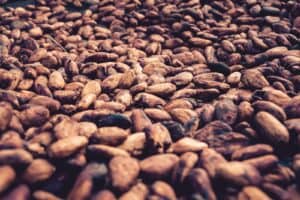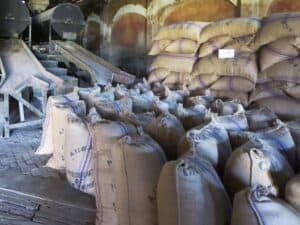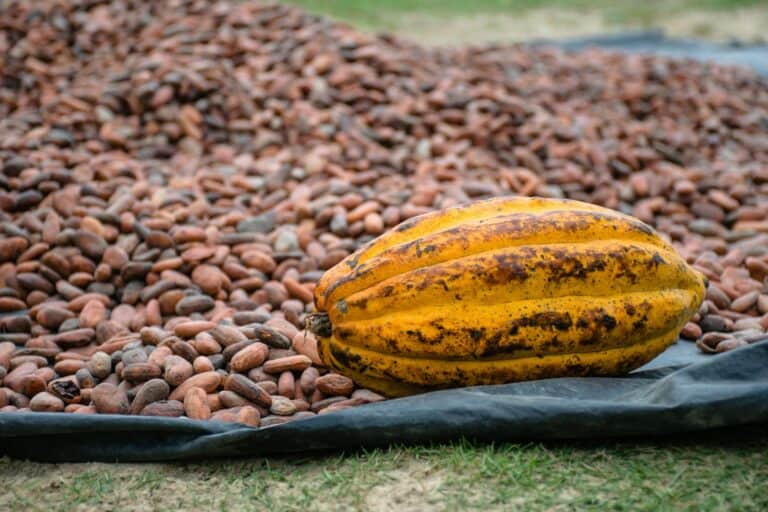Storing cocoa beans isn’t just about finding a space; it’s about preserving their quality and ensuring they’re as good as when they were picked. That’s where cocoa bean storage best practices come into play. These methods are not just about keeping beans safe; they’re about maintaining their flavor, aroma, and overall quality.
With the right techniques, you can tackle common challenges like poor ventilation, pest attacks, and mishandling, which often threaten the quality of cocoa beans. Embracing cocoa bean storage best practices means investing in the future of your cocoa, ensuring it remains top-notch from warehouse to chocolate bar.
Monitoring Humidity Levels

When storing cocoa beans, it’s critical to ensure that the relative humidity levels in your storage area are carefully managed. Relative humidity plays a pivotal role in preserving the freshness and quality of cocoa beans, as both low and high humidity levels can lead to significant quality degradation. Ideally, the humidity should be maintained between 65% to 70% to prevent mold growth and insect infestation, which are among the top concerns when preserving cacao beans.
In environments with High Humidity, moisture can accumulate, leading to mold formation and causing the cocoa beans to clump together. This not only affects the beans’ flavor and aroma but also increases the risk of contamination from potential contaminants. On the other hand, Low Humidity can cause the beans to dry out, affecting their moisture content which is crucial for maintaining cocoa freshness throughout the fermentation process and beyond. Monitoring devices, such as a hygrometer, can be used to accurately measure and track the relative humidity levels in the storage area, ensuring they stay within the recommended range.
To tackle humidity challenges, consider implementing practices like using dehumidifiers or silica gel packets to control moisture levels or ensuring your storage area is well-ventilated. It’s also important to store cocoa beans in materials that breathe, like Jute Bags, which provide protection while allowing air to circulate freely around the beans. By keeping a close eye on humidity levels and taking preemptive steps to mitigate any issues, you’ll be adhering to cocoa bean storage best practices, optimizing both the longevity and quality of your cocoa beans.
Proper Ventilation

When it comes to cocoa bean storage best practices, understanding the pivotal role of proper ventilation cannot be overstated. Positioning your cocoa beans in a well-ventilated place is critical for preserving their quality, preventing mold growth, and controlling moisture content. Ventilation ensures that any moisture exuded during the natural fermentation process or absorbed from the air is swiftly carried away. This action keeps the environment around the cocoa beans dry, making it less inviting for mold and insect infestation. Remember, maintaining cocoa freshness hinges not just on controlling temperature and humidity but also on ensuring constant air circulation around the beans.
In the context of storing chocolate seeds or cacao beans, choosing the right storage containers and packaging solutions can make a significant difference in ventilation efficacy. Jute bags and breathable plastic bags designed for agricultural produce offer air circulation advantages, allowing moisture to escape and fresh air to enter. This is crucial during the transport phase as well, where cocoa beans might be exposed to varying environmental conditions. Making sure that containers are not overly packed and that there’s space between bags promotes airflow, helping to preserve cacao beans effectively throughout their journey before processing begins.
While focusing on cocoa bean storage, it’s essential to consider the storage space itself. A room or warehouse designated for cocoa bean storage should be engineered or chosen with ventilation in mind. Features like vents or fans that promote a constant exchange of air can greatly reduce humidity levels and prevent moisture damage. Moreover, keeping cocoa beans off the floor and away from walls helps in minimizing the risk of contamination and mold development. By prioritizing a ventilated place and mindful storage practices, you ensure cocoa’s freshness, flavor, and quality are maintained from harvest to production, laying the groundwork for exquisite chocolate creation.
Pest Control Measures
When you’re focused on preserving the quality of cocoa beans, implementing effective pest control measures is critical. Rodents and pests not only pose a risk to the storage integrity of cocoa beans but also can significantly impact their quality and freshness. In your efforts to maintain cocoa freshness, it’s imperative to adopt a multifaceted approach to pest management, combining regulatory, cultural, biological, and chemical controls to ensure comprehensive protection.
Regulatory control involves adhering to strict guidelines to prevent the transport of potentially contaminated materials. These measures are particularly crucial in avoiding the spread of pathogens from one area to another. For cocoa bean storage best practices, this translates to ensuring that the jute bags used for transporting cocoa beans are free from contaminants that could introduce pests into a clean environment.
Cultural and biological controls are about creating conditions that deter pest presence and activity. This includes storing bags in a cool, dry, and well-ventilated place, which helps in maintaining optimal temperature and humidity levels. Low humidity and cool temperatures are not conducive to insect infestation, reducing the odds of pests laying eggs or causing mold growth on cocoa beans. Chemical control, though used sparingly, involves applying substances that are toxic to pests but safe for cocoa beans, providing an additional layer of protection against potential contaminants. Remember, the goal is to keep the cocoa beans and their environment in a state that minimizes the risk of contamination and preserves their indispensable flavor and aroma as they are stored or transported.
Temperature Control

When focusing on cocoa bean storage best practices, temperature management emerges as a cornerstone for preserving cacao beans effectively. A stable temperature not just maintains cocoa freshness but also plays a pivotal role in warding off mold growth and insect infestation. For optimal storage conditions, ensure your cocoa beans are kept within a temperature range of 60-70 degrees Fahrenheit (15-21 degrees Celsius). This range helps in slow fermentation, crucial for developing the beans’ complex flavors and quality, while preventing the buildup of moisture which could lead to spoilage.
Managing temperatures in storage involves understanding the balance between too cold and too warm. Too cold, and you risk slowing down the fermentation process excessively or causing condensation when beans are moved to warmer areas, potentially leading to mold and flavor degradation. Too warm, and the beans may over-ferment, increasing the risk of insect infestation and mold growth, both of which can severely affect the beans’ quality and aroma. Investing in thermally controlled storage areas or containers can provide protection against these risks, ensuring your cocoa stays at its best.
Lastly, consider the implications of fluctuating temperatures. Consistent temperatures prevent stress to the beans that can result from moving them between areas of varying temperatures, whether in storage or during transport. Thermal blankets or insulated packaging can be effective solutions when transporting cocoa beans, minimizing temperature variations that can compromise the quality and freshness of your cargo. By prioritizing temperature control, you’re taking a significant step towards maintaining the integrity and flavor of your cocoa beans, ensuring they remain in prime condition from harvest to production.
Handling and Transportation Guidelines
When it comes to transporting cocoa beans, maintaining their freshness and quality during the journey is crucial. The key to successful transportation lies in understanding the factors that can jeopardize the integrity of cocoa beans. Heat, moisture, and improper packaging can lead to fermentation process issues, mold growth, and insect infestation. To mitigate these risks, ensure the cocoa beans are dry before they’re placed in jute bags or other suitable packaging materials. These containers offer protection against moisture and pests while allowing the beans to breathe, preventing condensation that could lead to mold.
Relative humidity and temperature control are paramount during transport. Aim to maintain conditions similar to those in ideal storage scenarios; keep the humidity around 65-70% and temperatures in the range of 60-70 degrees Fahrenheit. Using ventilated transportation modes can help maintain these conditions, protecting the cocoa beans from moisture damage and preserving their flavor and quality. Inspect the transport vehicles for cleanliness to avoid contamination from potential contaminants like dust and previously transported goods.
Throughout the journey, periodic checks are essential to ensure that environmental conditions remain within the desired ranges. Avoid storing cocoa beans near products with strong odors or those that might attract pests, as these can affect the flavor and quality of the beans. By prioritizing these handling and transportation guidelines, you’re taking significant steps towards preserving cacao beans and maintaining cocoa freshness, ensuring that they reach their destination in optimal condition, ready for the next stage in the production process.
Final Thoughts: Cocoa Bean Storage Best Practices
Storing cocoa beans isn’t just about keeping them somewhere cool and dry. It’s about understanding the delicate balance between temperature, humidity, and cleanliness to prevent any damage that could compromise their quality. By following the guidelines outlined—ensuring beans are dry before packaging, choosing the right containers, and maintaining the ideal conditions during transport—you’re setting the stage for cocoa beans to retain their freshness and flavor. Remember, the effort you put into storing these beans right pays off when they’re transformed into delicious chocolate products. So, take these practices to heart and make sure your cocoa beans are stored perfectly every time.
Other suggested articles:
